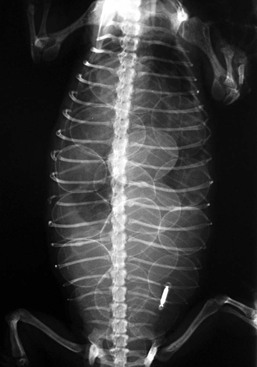Richard M. Jakob-Hoff The tuatara is the only extant member of the order Sphenodontia. Previously found throughout New Zealand, tuatara are now restricted to approximately 35 offshore islands.8 Rats (Rattus norvegicus, R. rattus, R. exulans) are considered the primary threat as predators of tuatara eggs and juveniles and competitors for food.4 A recent taxonomic review concluded that all populations comprised a single species, Sphenodon punctatus.9 Superficially similar to lizards, tuatara have a number of anatomic and physiologic features that, collectively, place them in their own order: (1) unique dentition,10 (2) absence of an external auditory aperture,15 (3) absence of a male intromittant copulatory organ,4,7 (4) abdominal ribs (gastralia) reinforced by uncinate processes,7,19 (5) a parietal eye,7,15 and (6) activity at a low body temperature range between 2 and 22° C with maximal level of activity at 17° C.14,17 Nelson N. (personal communication, 2013) has gathered verifiable evidence of tuatara conservatively estimated to be 91 years old. Adult male weights vary between 400 and 1000 grams (g) with a snout–vent length (SVL) of 200 to 290 millimeters (mm), and females weigh 200 to 500 g with an SVL of 180 to 240 mm.7 Sexual maturity occurs at 13 to15 years of age.4,7 Females reproduce, on average, once every four years,4 with mating occurring in late summer (January to March) and ovulation in April.5 Significant seasonal variation is seen in sex steroids in both sexes corresponding to courtship and mating behavior. Both sexes may engage in aggressive interactions during the breeding season, and severe biting may result in facial wounds, fractured mandibles, and detached tails.4 Radiography in September to October provides a reasonable estimate of the proportion of gravid females with shelled eggs (Figure 6-1). Up to 19 soft-shelled eggs are laid 10 to 50 centimeters (cm) deep in sunny areas.6 Depending on the temperature, incubation may take 11 to 16 months,4 with predominantly females produced at 20° C and males at 23° C.13 After hatching, remnants of the midventral yolk sac persist for a few days.7 Captive housing and husbandry have been well described elsewhere.1,2,14 Housing features critical to the good health of the tuatara are (1) a minimum of 5 square meters (m2) per adult animal,14 (2) porous soil substrate to allow for natural burrow construction and egg laying, (3) adequate insulation of artificial burrows to protect from excessive heat, cold, and moisture, (4) a variety of low-growing shrubs, rocks, hollow logs, and other cage furniture to provide visual screens between animals, refuges, shade, and opportunities for sun basking and exercise, (5) ambient temperature of 4° C to 15° C in winter and 10° C to 25° C in summer,1 with the animals being given a choice of thermal gradients, (6) relative humidity maintained within the range 85% to 95%,1,14 (7) basking opportunities providing 100 to 250 microwatts per square centimeter (µw/cm2) of ultraviolet B (UVB) (290–315 nanometer [nm], lower exposure in winter, higher in summer) and warmth for two hours in the morning and in the afternoon (Gibson R, personal communication, 2013), and (8) open ponds to enable the animals to soak in shallow water. This frequently stimulates defecation and helps prevent dysecdysis in the annual molt. Captive diets should mimic the wild diet7,14,18 as far as possible and include a variety of live invertebrates such as crickets, locusts, mealworm larvae, beetles (Tenebrio sp.), moths, earthworms, snails, woodlice, and occasionally in summer, small bird eggs or newly hatched chicks. At the Auckland Zoo, invertebrates are dusted with a high-calcium multi-vitamin and mineral powder (Miner-All, Sticky-Tongue Farms, Sun City, CA).
Sphenodontia
The Biology and Veterinary Care of Tuatara
General Biology
Taxonomy and Status
Anatomy and Physiology
Growth and Development
Reproduction
Special Housing Requirements
Feeding
Stay updated, free articles. Join our Telegram channel

Full access? Get Clinical Tree



